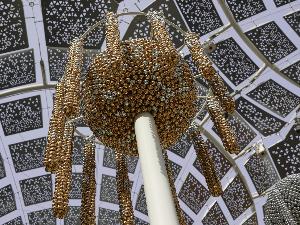Haegue Yang
Haegue Yang
Born: 1971
Biography:
Haegue Yang is a South Korean artist primarily working in sculpture and installation. After receiving her B.F.A from Seoul National University in 1994, Yang received an M.A. from Städelschule where she now teaches as a professor of Fine Arts. She currently lives and works in Berlin and Seoul. With the statement “I believe that out of the alienation one can mobilize the unusual strength to sympathize with the others,” Yang seeks to embrace vulnerability, thus exploring themes that may include “individual and national identity, displacement, isolation, and community.” Yang also ensures an ambiguity to avoid “tying herself to one [identity] based on gender, race or geography.” Therefore, Yang's work often places disparate household objects, including yarn, light fixtures, and fans, into alternative configurations, exploring meanings they can take on outside of their typical functional uses. She is particularly well known for her installations incorporating venetian blinds that transform galleries through their filtering of light, segmentation of space, and large scale that requires audiences to find multiple viewpoints in order to see the work. Her installations using materials like bells, moving theater lights, and scent diffusers engage multiple senses by incorporating lights, smells, sounds, and tactile materials that reorient and recalibrate viewers' perception. With the additional exploration of her mural-like graphic wall pieces, juxtaposition and abstraction are included for an enhanced dramatic, immersive scenery. Yang draws from a wide array of references, including her own biography, historical events, film, and literature, to create installations like Sadong 30 (2006) and performances like The Malady of Death (2010-ongoing). A number of her works consider movement both within the exhibition space with moving sculptures such as Dress Vehicles (2012), and on a global scale with outdoor commissions like Migratory DMZ Birds on Asymmetric Lens (2020). Overall, the materiality, references, and engagement in Yang's art create a "communicative way of sharing life," by allowing individuals within an intervening space to "imagine events with others."


